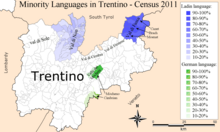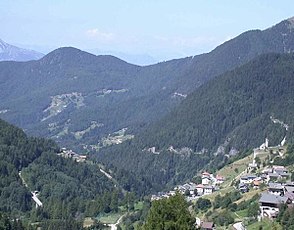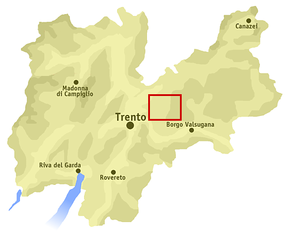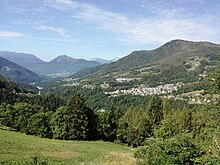Heel valley
| Fersental - Bersntol Valle del Fersina - Valle dei Mocheni |
|
|---|---|
|
The upper Fersental with Palù del Fersina |
|
| location | Trentino , Italy |
| Waters | Torrente Fersina, Lago di Erdemolo |
| Mountains | Fiemme Valley Alps |
| Geographical location | 46 ° 6 '26 " N , 11 ° 18' 27" E |
| Type | Kerbtal |
| rock | Sedimentary rocks , porphyry |
| height | 700 to 1000 m slm |
| particularities | German language island |
The Fersental , in Fersentalerisch Bersntol (also officially in the name of the valley community Comunità Alta Valsugana e Bersntol ), Italian Valle del Fersina or Valle dei Mocheni , is one of the German- speaking islands in Northern Italy .
The Fersental is located in the Trentino-South Tyrol region , Province of Trento , is a northern side valley of the upper Valsugana (German Suganertal ) near Pergine (German Fersen ) at an altitude of 700 to 1,000 m above sea level.
The Fersentaler villages Eichleit (Roveda) and Gereut (Frassilongo) form a municipality, the municipality Florutz (Fierozzo) consists of the hamlets St. Franz and St. Felix. The head of the valley is Palai (Palù del Fersina) . The main town of Sant'Orsola Terme on the right side of the valley is Italian-speaking.
history
Traces of settlement and mining are already detectable for the Bronze Age , but there is no evidence of continuous and permanent settlement.
The Fersental was in the 13./14. Settled in the 18th century through immigration from various valleys in North and South Tyrol , possibly in two steps: First, mining settlements were established for the extraction of copper, silver and gold (formerly the silver mine at the end of the valley), later farmers settled.
Since the Fersental allowed only a small livelihood, the men in particular engaged in wandering trade from at least the first half of the 17th century until the 20th century . The shopkeepers ("Krumern") practiced their profession in the entire area of the Habsburg Monarchy .
From 1865 until the fascists came to power (1922) there was a German school in Fersental.
During the First World War , the Fersental was on the Austro-Hungarian side just behind the Dolomite front, which ran immediately south of Lusern and ran through the middle of the seven municipalities .
After the end of the First World War, the Fersental came to Italy in 1919 through the Treaty of Saint-Germain, together with Welschtirol .
During the Fascist era (1922–1943), all heeled traditions and the language were suppressed and forbidden not only in public but even in private: Mussolini and Ettore Tolomei pursued a ruthless policy of Italianization in all Fersental communities, as in South Tyrol.
Due to an agreement between Adolf Hitler and Benito Mussolini in 1939 by Mocheno had to option to decide whether to resettle as a German to the German Reich or wanted to stay as an Italian in the home. Intense National Socialist propaganda resulted in many valley residents opting for resettlement. In 1942, a total of 556 people were resettled from the Fersental to Czech villages near Budweis , from which the residents had been driven: 330 from Palai, 183 from Florutz, 9 from Gereut and 44 from Sankt Ursula. The abandoned property was acquired by the Deutsche Abhabenstreuhandgesellschaft (DAT). In 1945 the resettlers had to leave their new homes and most of them returned to their old homeland. Here they were initially like strangers in their own country, because they had had to sell their land. It was not until Law 889 of August 3, 1949 that the Italian state ordered the property to be returned.
The poor conditions in the Fersental have resulted in increased migration for decades. Many heelers worked as guest workers in Switzerland and Germany, but most of them in industrial areas in Trentino or elsewhere in Italy. As in many other linguistic islands, the commuting, especially of the young Fersentaler, to the industrial towns in Trentino led to a constant decline in the Fersentaler dialect and to slow emaciation. There was also no school for the children in their mother tongue. However, those who worked in the German-speaking area brought home a good knowledge of German. This also applied to Fersentaler who worked in South Tyrol.
Today, the Fersentaleric is still widespread in Palai, Florutz and Eichleit in everyday life, while in Gereut it is only spoken by a minority.
In the last few years, the decline of the heel tongue (as well as the Cimbrian ) has been stopped, because now the province of Trento and the region of Trentino-Alto Adige not only support the preservation of the language with EU funds , but also tourism projects and the economy support, so that more and more young people from heels can find economic prospects in their homeland.
In 1987 the Province of Trento founded the Bersntol-Lusérn Cultural Institute. The head office is in Palai, but a branch is in Lusern, that Cimbrian village on the plateau of Lavarone south of the Val Sugana , which is only about 10–15 km as the crow flies from the Fersental, but the adventurous Kaiserjägerstraße has to be overcome . Lusern was best able to preserve the Cimbrian and in many ways it can be regarded as ideal, but also as exemplary for all the language islands of the Cimbri. The Fersentaler maintain very close contacts with Lusern people (detailed information in the main article Lusern). In the meantime there is also a supraregional cooperation with the other Upper German language islands in Italy (seven municipalities, Sappada , Sauris , thirteen municipalities , Timau ).
language

The Fersental idiom was recognized as Bavarian as early as the early modern times . The German dialect of the Fersental is strongly influenced by Tyrol and differs significantly from the Cimbrian language islands in terms of sound level and vocabulary. Therefore, the view is taken that the Fersentaler are not to be counted among the Zimbri. The Fersentalers themselves, however, maintain close relationships with the Zimbri towns. Since many people from Fersental were active for centuries as traveling traders selling all kinds of goods in Tyrol and beyond, there was continuous contact with the closed German-speaking area. This is what distinguishes the Fersental from all the Cimbrian language islands.
According to the 2002 census, in which data on the mother tongue was recorded for the first time, Fersental German is predominantly spoken in the following communities (data refer to "belonging to the Fersental language group"): Florutz / Fierozzo / Vlarotz (423 people, 95.92%), Palai / Palù / Palae (184 people, 95.34%), Gereut / Frassilongo / Garait (340 people, 95.24% - also includes Eichleit / Roveda). In other municipalities in Trentino, 1,331 people stated that they belong to the Fersentaler language group, a total of 2,278 in Trentino. According to other sources, the Fersental dialect is used by almost everyone in Eichleit and Palai, the majority in Florutz, but only a small minority in the village of Gereut as the actual colloquial language.
For several years, Fersentalerisch has been recognized as a minority language in Trentino alongside Cimbrian and Ladin .
Multilingualism in school
After 1918, Italian was the only language of instruction in schools in the Fersental for a long time. With the recognition as a minority language, the heel tongue is gaining importance again today, as is the written German. In the Florutz elementary school, the Fersental dialect has been offered as a compulsory subject from the first grade for several years. In addition, there are two languages of instruction at this school - as the only one in Trentino so far, initially on a trial basis: Italian and German. A study in 2009 showed that children with knowledge of the dialect had considerable advantages in German-language lessons compared to their Italian classmates who had previously been monolingual.
Naming
Apart from a few Romance names, there are mostly German names. In the absence of a standardized written language, the same verbal name is often spelled differently, for example Hos, Oss, Haas for 'rabbit'. The family names that occur frequently in the Fersental today - for example Marchl, Moar, Hoss, Korn, Toller, Stefani, Laner, Moltrer, Hueller, Eccher - can be traced back to the first settlers.
The courtyards were named after the nature or topography of the area ( e.g. Habichthof, Hoslerhof, Puechhof ) or after the name of the family who founded the farm ( e.g. Turrerhof, Prighelhof ).
The place name Palai is an early German translation from Italian palude ('swamp').
The Italians call the Fersentaler Mocheni because they often use the verb mochen ('make'). This designation has partly been adopted in general and scientific terminology.
tradition
The ore mining has strongly influenced culture and tradition in imagination, stories, legends and sagas.
An archaic ceremony is held every year on Shrovetide .
Recently, an old copper mine has been restored and opened to the public, the Grua vo Hardömbl in Palai. Inside the mine, part of the load-bearing structures, tunnels and wooden stairs, which date from the 16th century, can be seen.
The typical design for the Fersental is the block construction, which consists of individual trunks with a diameter of about 25-40 cm, which are cut into a square, are layered on top of each other and block each other with notches and thus anchor each other. The corners are mostly walled up in the lower area.
The courtyard building consists of two floors: on the ground floor are the stable (Stòll), the brick living area and work areas. On the upper floor there is the wooden haystack and above it the roof covered with shingles.
An impressive courtyard in traditional architectural style is the Filzerhof in Florutz (Italian: Fierozzo), the restoration of which is primarily due to the Bersntol-Lusérn cultural institute. Various typical courtyards have been preserved to this day.
The heel valley in art
- Robert Musil's story Grigia (in: Drei Frauen, 1924) takes place in the Fersental.
literature
- Karin Heller, Luis Thomas Prader and Christian Prezzi (eds.): Lebendige Sprachinseln. 2nd edition, Bozen 2006. Online to the Fersental.
- Hans Mirtes: The Fersental and the Fersentaler. On the geography, history and folklore of a German-speaking island in Trentino. Regensburg: Inst. For Geography at the Univ. Regensburg (Regensburg geographical writings; also Univ. Regensburg, diss.) 1996.
- Folklore studies by R. Wolfram
- Linguistic studies by C. Battisti, M. Hornung, A. Rowley
- A. Rowley: Heel Valley Dictionary. Hamburg 1982
- F. Faganello, A. Gorfer: The valley of the Mocheni. Calliano 1972
- Max von Prielmayer: German language islands. In: Journal of the German and Austrian Alpine Club. Born in 1905. Volume XXXVL. Innsbruck 1905, pp. 87-112
Web links
- Fersental communities
- Fersentaler Kulturinstitut The informative magazine Lem of the Kulturinstitut Bersntol (Fersental), which is usually published once a year, can be downloaded as a PDF file. Lem is trilingual ( Italian , German and hyper-tolerant / heel-mental).
Individual evidence
- ↑ Comunità Alta Valsugana e Bersntol , official website, accessed on January 4, 2016.
- ↑ Appartenenza alla popolazione di lingua ladina, mochena e cimbra, per comune di area di residenza (Censimento 2001). (PDF; 27 kB) Annuario Statistico 2006. Provincia Autonoma di Trento. 2007. Read on August 21, 2011.
- ↑ Giulia Gatta: The Influence of the Heel Throat on Learning the German Language - A study carried out in the Florutz elementary school. LEM, Bersntoler Kulturinstitut, December 5, 2010, pp. 12-17.


